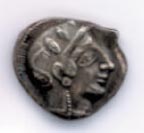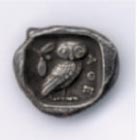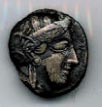
|
An Invitation from Athena By Jason C. Mavrovitis The first time I saw the coin shown in the photograph below, it fell into my hand from an envelope that had been cushioned in a bed of cotton in a very small white box. Carefully written in pencil on the envelope were the words: "DRACHMA -- COIN OF ATHENS -- 430
To the right is the reverse (back or tail) of the same coin. The standing owl is accompanied by an olive branch with two leaves and a berry, over its shoulder, and the Greek letters Alpha Theta
The coin was a gift from Miss Edith Arms, who had been my wife, Bette's, kindergarten teacher. They were reacquainted in a chance meeting on busy Telegraph Avenue, in Berkeley, California while Bette was a student at the University of California, and subsequently became close friends. Miss Arms introduced our children to Barbar (in French!), and to Eloise, and her adventures at the Plaza Hotel -- giving them the books as Christmas presents. One Christmas she surprised us with the little coin that her uncle had bought in Athens as a souvenir of his tour of Greece in 1910, and later presented to her as a gift.
"Hello, I am a novice, not really even a collector yet." A warm smile greeted me. "That's fine. How can I help you?" I reached into my pocket, took out the little box, and removed the coin from its envelope. "I have this drachm of Athens, and can't identify it. Can you?" The dealer took the coin and inspected both of its side quickly, not using the 10 power magnifying loop that I watched many dealers and collectors employ as they evaluated a coin. He looked a little concerned or questioning. "How long have you had this coin?" "Over thirty years." "What did you pay for it?" "Nothing -- it was a gift from an old family friend. She passed away." "What do you think it is worth?" "I have no idea. What is it?" "Well, it is a forgery." "What?" "Yes, a forgery. You can tell by the perfectly flat flan, especially on the reverse. See, the reverse is the 'tail-side, ' where the owl is. Look how flat the surface is around the owl. And see how clear every detail of the owl, the olive leaves, and the letters are?" He saw both my questioning face and look of disappointment. Turning to one of his colleagues he said, "Look at this -- a Christodoulos?" The other dealer took the coin. He did not know it, but he made me feel better by using his magnifying loop. "Absolutely, Christodoulos," he said. "Is it yours?" "Yes," I answered. "Well, it is worth something, maybe $25." "Who was Christodoulos?" I asked. "A very prolific counterfeiter, active in Athens around 1900. He sold lots of his coins to tourists. There is even a catalogue of his counterfeits!" The dealer seemed overjoyed.
I stopped at the table of Wayne Sayles, who had a box full of bronze Roman coins with a little sign on it -- $5 to $25 -- and introduced myself. He was not busy, so took the time to show me some Roman coins and answer questions. We came upon a coin of the Emperor Justinian, who I thought of as Byzantine, not Roman. Sayles reminded me that the Byzantine Empire was the successor to the eastern Roman Empire. At home I re-read Norwich's Byzantium -- The Early Years, which confirmed that Justinian was the last of the emperors considered to be Roman rather than Byzantine, one whose "mind was cast in a Latin mould, and that throughout his reign...devoted the greater part of his prodigious energies to the restoration of the old Roman Empire." 3 Only $15 for the Justinian! I purchased it, and another of Constantius I, the father of Constantine the Great, for another $15. Now, they were not great coins. The Justinian was off center, with barely visible lettering. Constantius I was in better shape, and the lettering on its obverse was legible -- not that I understood the words the letters formed. I left Mr. Sayles as a collector, with two coins and a lot of advice about buying books before I purchased coins. I followed Sayles guidance. The book I purchased next was his Ancient Coin Collecting. 4 And I subscribed to The Celator, a periodical devoted to ancient coins. Slowly, I built a small library, and made coin purchases from mail catalogue auctions and at bourses, but my collection lacked the coin I most wanted, an Athenian tetradrachm. The problem was to find one that I both liked and could afford. The reasons one may want a particular coin for a collection are varied. In this case, the best I can do is to state the obvious: the history of ancient Greece fascinated me; Athens was the center of the classical Greek world; Athena, the helmeted war-goddess, was its patron; and she appeared on the coins of Athens for more than one hundred years. Huge sums must have been necessary for the commercial activities of Athens' port city, Piraeus, construction atop the Acropolis and in the city, financing of the Athenian fleet, and perennial warfare. The money was derived not only from annual tribute received from the Delian League city-states, but from rich silver deposits Athens owned and mined at Laurium, close to Cape Sunium as well. The mines provided the silver that paid for construction of the fleet that destroyed the Persians at Salamis in 479 B. C. E. Common to all issues of the coin are the goddess Athena, in profile on the obverse, and the owl, her constant companion, standing on the reverse, a sprig of olive leaves with a berry above its shoulder. Variations in design exist among denominations of the coin (there were up to nine such, the smallest, a tetartemorion, equal to 1/ 24 th of a drachm, weighed 0.22gms -- 0.0056oz.). There are many deviations in the countenance and costume of Athena on the obverse of coins of this type. There are equally many differences in the representation of the Owl of Athens on the reverse where the owl, olive leaves, berry, and crescent moon are symbols whose style of execution are idiosyncratic to a particular issue. After 480-470 B. C. E., an olive diadem was added to Athenas' helmet, and a crescent moon appeared over the owl's shoulder. The crescent moon has been interpreted as representing the waning moon, the phase that occurred at the time of Athenian victories over the Persians at Marathon and Salamis. It may be, however, that it was added only as a reference to the nocturnal habits of the owl. Athenian coins were universally known as "Owls". The owl was sacred to Athena and as she was the personification of wisdom, it was symbolic of that attribute. In the Iliad, Homer sometimes used "Owl Eyed Athena, " as an epithet for Athena. Scholars have also noted that the Acropolis was the home of small owls whose faculty of excellent night vision would be useful to the Athena in her role as a warrior and the city's protector. The olive tree was sacred to Athena for she created it in a contest with Poseidon for the possession of Attica. The presence of the olive leaves on her helmet, and leaves and berries on the reverse of the coin refer to her symbolically.
The artist who created the die for this coin sculpted a remarkably beautiful profile of
Most appealing to me about the coin I selected is the fact that the artist, two and one-half thousand years ago, sculpted an almost exact resemblance to the profile of my daughter, Reveka Evangelia Mavrovitis. The ancient Greek city-states took great care to make their coins wonderful works of art and symbolic of their origin and time. They provide collectors with a never-ending source of intellectual pursuit, and visual and tactile pleasure. 1 N. G. L. Hammond, A History of Greece to 322 B. C (Oxford: Clarendon Press, 1959). Back to Classics (Posted May 2003) For more information about the author, see his biographical sketch under the Contributing Authors' section of HCS, or visit the author's website at http://www.goldenfleecepublishing.com. Mr. Mavrovitis has written a number of fine articles for HCS which readers can browse or read at the URL http://www.helleniccomserve.com/archivemavrovitis.html. 2000 © Hellenic Communication Service, L.L.C. All Rights Reserved. http://www.HellenicComServe.com |




